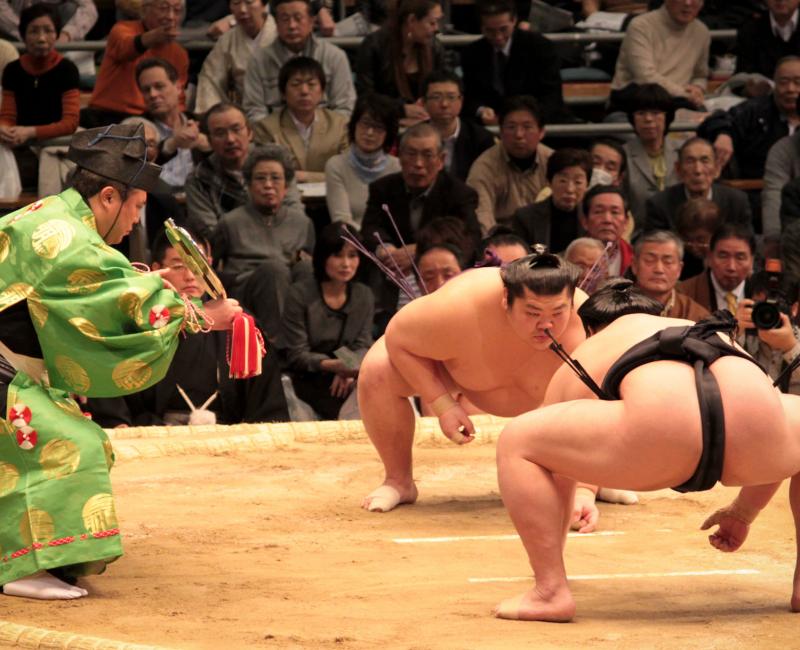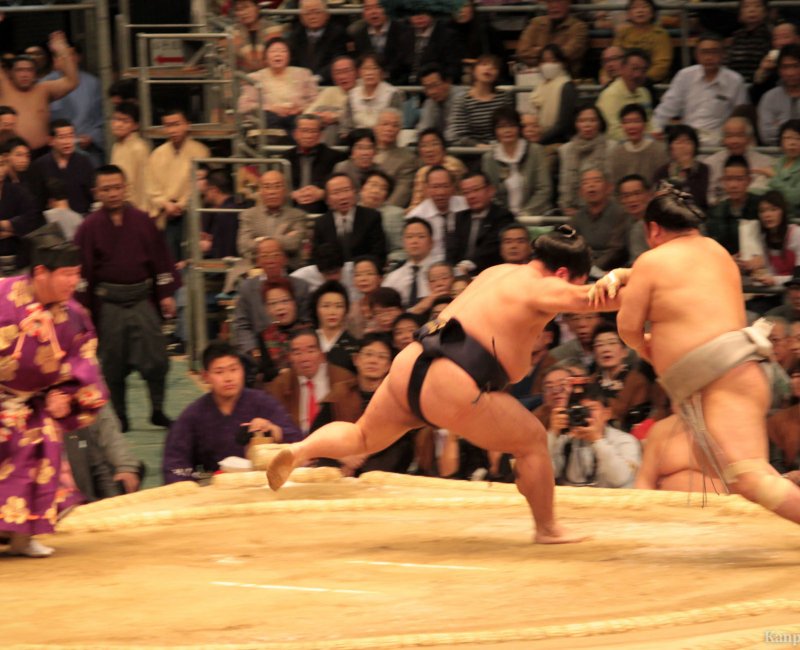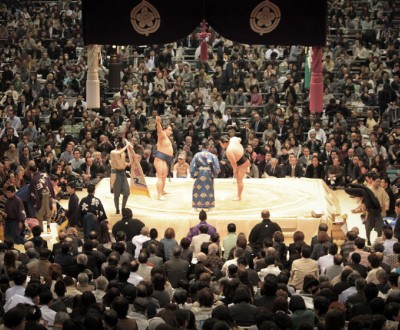Sumo tournaments in Japan
A Complete Guide
Sumo tournaments in Japan consist in six big yearly official competitions of Japanese traditional wrestling. They take place on odd months in Tokyo, Osaka, Nagoya and Fukuoka, providing many occasions to travelers in Japan to live an unusual experience.
There are several ways to book seats, but the most common is to reserve through the official website (see the link in the Information section down the page). We bought our tickets in Japan at a konbini store, for a March tournament in Osaka.
We were not especially fond of Sumo. While we did stumbled upon it on TV, we did not know about the folklore related to this discipline and we came to the tournament as neophytes. Tickets grant access to the building all day long.

Program of the day
A typical wrestling day begins in the morning and continue until the Yokozuna appears (Hakuho, in this case) in late afternoon. *He* is the star: during the 300-year history of Sumo, only 69 wrestlers have been promoted to this half-god title. The other ones are called Rikishi rather than Sumo.
The day sees a succession of Sumo bouts keep on happening with a gradual increase in league. A tournament day usually ends around 6 or 7 p.m. Tickets allow to exit and come back once in the stadium, for example to go and get your lunch outside. Otherwise, you can naturally still find food and beverage stalls within the gymnasium.
A typical tournament day usually unfolds like this:
- 8 a.m. – Maezumo, sumo beginners who step on the dohyo ring for the first time
- 8:30 a. m. – Bouts of the Jonokuchi / Makushita divisions
- 12:30 p.m. – Entrance ceremony (dohyo-iri) of the Juryo division
- 3 p.m. - Bouts of the Juryo division
- 3:50 p.m. – Entrance ceremony of the Makuuchi division
- 4 p.m. – Entrance ceremony of the Yokozuna
- 4:10 p.m. – Bouts of the Makuuchi division
- 6 p.m. – Bow-twirling ceremony and awards.
Sometimes a Sumo comedy routine called Shokkiri can also be performed by the wrestlers.
The schedule may vary according to the tournament and the day. For example, on the championship’s first and last days, two additional ceremonies take place at 3:30 p.m. and 5:15 p.m. It is often quite difficult to get tickets for these days.
Most of the audience is composed of middle-aged and older men, and there are very few young people attending these tournaments.
Since 2011, at the end of each tournament, the winning Sumo is offered a giant macaron (41cm diameter and 23 cm high) as a trophy to symbolize the French-Japanese friendship. This confectionery, made by pastry chef Pierre Hermé is a gift from the French Embassy in Japan. As the giant macaron is not edible, the wrestler is also given a classical box of macarons!

How to choose the seats
Tickets to the tournament have a digressive rate the further away you sit from the dohyo (the ring), pretty much like in a stadium. Sumo wrestlers are positioned east and west, the gyoji (referee inside the circle) is facing south and north, and the preparation of Sumo (Shiko) is to the southeast and southwest. Yokozuna’s ceremonies are facing north.
For all these reasons, we recommend booking your seat in the north gallery, and if possible not too high: you can see more of the wrestle and obviously they are much more impressive as you are near the dohyo. Also the back rows are western style bleachers, narrow and uncomfortable, while the "cubicles" a little lower cover about a small square meter and are more comfortable, with cushions.
If you’re staying there for an entire afternoon, being able to extend the legs can be very appreciated. So it may be worth to spend at least ¥7,000-8,000 (~US$48.85 to ~US$55.82) for a Sumo championship ticket. If you arrive in the morning, where there is few people, you can get very close to the dohyo to take pictures or make a video, get out at noon to eat in one of the restaurants nearby, then enjoy the big wrestles for the rest of the afternoon.
Note that the highest ranking Sumos are not necessarily Japanese. Thus, three of the most recent yokozuna were Mongols. In January 2016, the Japanese wrestler Kotoshogiku won Tokyo’s tournament, thus ending 10 years of foreign dominance (mainly Mongol, Bulgarian or Estonian). Then, his fellow citizen Kisenosato followed in January 2017.
For the record, the dohyo ring is off limits to women. In April 2018, two women rescuers were even chased away by a referee as they were trying to help an official who had a stroke during a speech.
---
We recommend at least attending one of these Sumo tournaments if you have the opportunity. It is very interesting, extremely spectacular and involves a lot of Japanese folklore.

